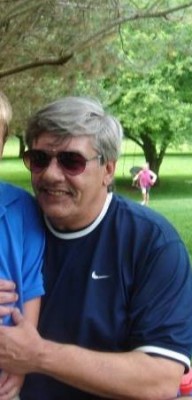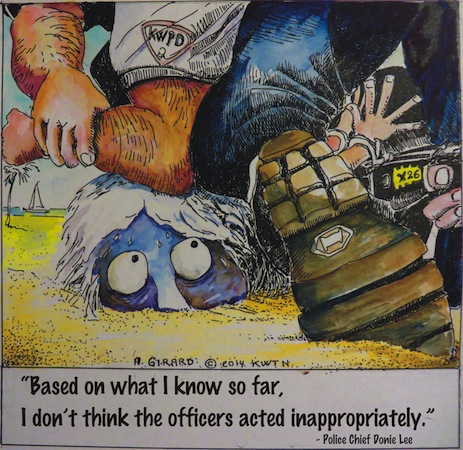POLICE CHIEF DONIE LEE ADMITS EIMERS MAY HAVE DIED BY ASPHYXIATION

by Naja and Arnaud Girard…….
The tragic death of a 61-year-old tourist while in the hands of Key West police officers is becoming increasingly controversial. After suggesting that Charles Eimers had succumbed to pre-existing “very serious heart problems” while resisting arrest, the Chief of Police admitted this week on US 1 Radio that Eimers may have died of asphyxiation.
Thousands have now become aware of a video taken by a bystander of Eimers’ arrest on Thanksgiving Day. It shows Eimers complying with police, laying down on the beach on his stomach and being handcuffed. However, within 5 minutes, the retired autoworker and father of four who dreamed of vacationing in Key West was dead.
Now that it is admitted that Eimers didn’t die of a heart attack, but quite possibly of a much more controversial case of asphyxiation, a troubling question arises: How is it possible that the news of such an event managed to pass almost unnoticed? Initially we saw only a short statement in the Key West Citizen regarding a man who had collapsed all of a sudden while resisting arrest on South Beach at the end of Duval Street.
Did the police department hope to shove this one under the rug? Eimers was initially identified by officer Gary Celcer as someone apparently “living out of his car.” Did they hope he might be one of Key West’s ‘unclaimed homeless’?
Things weren’t going to be so easy. For one thing, Eimers was on life support, an expensive situation that under Florida law can only be terminated after notifying family members. Four days after the incident, on December 1st, the police finally contacted Eimers’ family and as it turns out Charles Eimers was not a castaway who had runaground on Key West’s shores.
“I was making arrangements to get on a plane the next day,” says Treavor Eimers, Charles’ son. From then on things became more and more curious.
“From what the Key West police told me,” says Treavor, “I believed that for some incomprehensible reason my father got out of his car swinging at the police and that he collapsed all of a sudden, probably of a heart attack.”
The video, which appeared two weeks later in The Blue Paper, “was a huge shock,” he said.
In the meantime, Eimers was removed from life support seven days after the arrest and pronounced dead on December 4th. But even though the case clearly called for an autopsy, the medical examiner was not informed until a week later. Mysteriously the body was directed to Dean Lopez Funeral Home. According to Eimers’ son Treavor, the medical examiner blames the hospital, the hospital blames the police. In any case, the medical examiner informed Eimers’ relatives that his findings may be limited due to the delay of the autopsy.
Of course, all of that could have been accidental. The following was not. After Eimers’ death, responding to a tip, we went to interview witnesses on South Beach. One important witness was absent: ‘Joelle’, who had been the hostess at the Southernmost Beach Café on Thanksgiving morning. We took statements from a few people but when we hooked up with Joelle a few days later she told us the KWPD “chief investigator” in Eimers’ case had “ordered” her not to talk to us. Coworkers told us Joelle had begun to change her version of the Eimers arrest after having lunch with someone who works for the police department.
When we asked the City for the police reports we were given only one, which was released to all media on December 2nd. But, in fact there were three reports written the day of the incident. Two reports, one written by officer Kathyann Wanciak and the other by Mathew Johnson (who were on the beach with Eimers that day) were not released or mentioned. The only report released was written by Officer Gary Celcer, who was not even in the area until after Eimers had already lost consciousness. That was the report, based on hearsay, that described Eimers as coming out of his car “actively fighting” with police before collapsing while resisting arrest. However, one of the reports that was initially suppressed actually describes Eimers complying with police orders and mentions a Taser being drawn. Of the 14 officers on scene, only three initially wrote incident reports. The others were apparently instructed by the police union not to write anything down.
On December 2nd, 5 days later, Police Chief Donnie Lee became aware of the situation and ordered his officers to write supplemental reports or get fired. Six officers complied, reluctantly writing brief supplemental reports; one as short as ten lines and they all contained an additional six lines explaining how the report had been written under duress.
Strangely, the two reports by Wanciak and Johnson, which are dated November 28th, include the same statement as the others, declaring they had been written following the Chief’s December 2nd order, while under duress.
So, is there an orchestrated cover-up at the police department? Most likely not. The “turmoil” represents, for the most part, the extreme difficulties inherent in this situation: On the one hand, the Chief is trying to maintain the transparency and the image of the Department and on the other hand, the union lawyers must protect officers against self-incriminating statements or statements which could be used against them.
One might wish the Department would stop being so defensive and take a closer look at their procedures. Eimers was subjected to what is called “prone restraint”: The person is lying on his belly while being handcuffed. This method has become increasingly controversial since studies have found it has been responsible for numerous deaths from “positional asphyxiation”. A survey released in February 2010 by the Federal Department of Education found that several states have already banned state employees from using the prone restraint method in educational and mental health institutions while others have severely restricted its use. In England after a series of highly controversial deaths, prone restraint was banned nationwide, even for police departments unless the suspect presents an immediate danger to himself or others. When prone restraint is necessary, the suspect’s condition must be monitored constantly. The police procedure in Kent, England was amended in June of this year adding a requirement that a safety officer “[monitor] the person’s position continually whilst being restrained, as death can occur suddenly and develop beyond the point of viable resuscitation within seconds rather than minutes.”
In the U.S. certain states, like Colorado, have issued state-wide bans on the use of “prone restraint” for any non-emergency situation not involving an immediate threat of injury.
There is an abundance of information as well as visual demonstrations on YouTube explaining the risk of asphyxiation associated with the method of restraint used on Eimers. One factor is particularly striking: Even the best demonstrations of the ‘prone restraint’ method, videos created by police officers for police officers, show the suspect on his belly on a mat or on a hard floor. But, what happens when the “suspect” has his head in the sand; when every movement brings more sand into his nose and mouth? Eimers was lying face-down in the sand on South Beach with at least one officer kneeling on his back. Could the intrusion of sand have caused him to panic, giving the impression of resisting arrest? All of the civilian eyewitnesses we spoke with reported that Charles Eimers’ face was completely caked up with sand, all the way into his nostrils.
We found this interesting statement by a specialist on prone restraint [see video below]:
“If, in addition to your own weight, you have someone kneeling or laying on your back, that increases the amount of weight that you have to raise in order to increase the size of your chest. The greater the weight resting on the individual’s back and the more severe the degree of compression the more difficult it is for them to breath in. What happens then occasionally is that the individual begins to have air hunger and oxygen deficiency. The natural reaction to that is to struggle more violently. The perception of those persons trying to subdue the individual is that he needs more compression to be subdued. You then enter a vicious cycle in which compression makes air hunger, air hunger makes a greater struggle, and a greater struggle demands greater compression. Unfortunately in some of these circumstances the price of tranquility is death.”
~~~~~~~~~~~~~~~~~
To access all Blue Paper coverage of the death of Charles Eimers click here.
[Responsive_youtube https://www.youtube.com/watch?v=svveIfnxvgw]
Last Updated January 19, 2014


